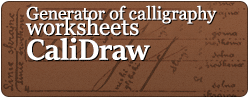Accessories and materials for calligraphy
Paper – for initial practice, office printer paper will suffice. You may also find special line sheets available for download on the website or sheets created using our calidraw app useful. As your skills develop, you would need to stock up on better quality paper. When choosing paper, attention should be paid to its hygroscopicity. Paper that soaks up too much ink creates jagged lines, which is not desirable.
Rulers – a good set of rulers is useful for drawing guide lines. A protractor is also very useful.
Pencils and eraser – as well as rulers essential for drawing guide lines.
Workstation – should consist of a comfortable chair, a flat and even desk surface and lighting. If you use a desk lamp, make sure it is on the side opposite the hand you are calligraphing. This is necessary because of the shadow that will fall on the paper. For comfortable work, a drawing board is also invaluable; although it is not required, it speeds up the process of drawing guide lines considerably. If you decide to get a drawing board, it is a good idea to have an adjustable angle of inclination.
Pen – there are many types of pen. To start with, it is best to get a pen with a barrel with several types of nibs of different thicknesses. Such calligraphy kits for beginners are in most art supply shops.
As your skills develop, you will definitely need to get better quality pens or nibs. A fountain pen with a fixed nib is also a good option, or parallel pens. We particularly recommend these because of their low failure rate and the fact that they are compatible with the templates from the last lesson, specifically the Pilot Parallel Pen – 2.4mm. For the purposes of our exercises – the wider the nib the better.
With italic script, try to avoid redis (redis) nibs with the characteristic round tip. They are good for other uses. Nibs (not fountain pens!) should be soaked in very hot water but not boiling water with detergent before first use – this will remove impurities from the nibs and the ink will adhere to them better.
Bird feather – preferably a goose feather and stubbed as shown here. Writing with a bird feather is a very special activity, but the process of crafting it correctly is not the easiest. If you will have trouble getting the bird pen to write properly – we recommend another tool.
Stick – yes! The Stick! Preferably from a lime tree, sharpened flat is also suitable for starting to play with calligraphy.
Marker – a special calligraphy marker with a suitably bevelled tip is a good instrument for mastering the basics. Different types of sets consisting of several pens with tips of different widths are available on the market. Such markers with a bevelled tip are produced by many different companies.
Ink, incaustic, paint – just like pens, there are many types and each has its own use. However, let’s not worry too much about this, because when you are initially learning calligraphy, ink is not that hugely important. To start with, you can get drawing ink or paint. However, we definitely do not recommend the cheapest Chinese inks. They can cause problems with the pen and cover the paper inaccurately. It is better to add a few dollars and buy ink from a more proven company. When using a stick instead of ink, black or any other colour of ecoline works well.



Recent Comments